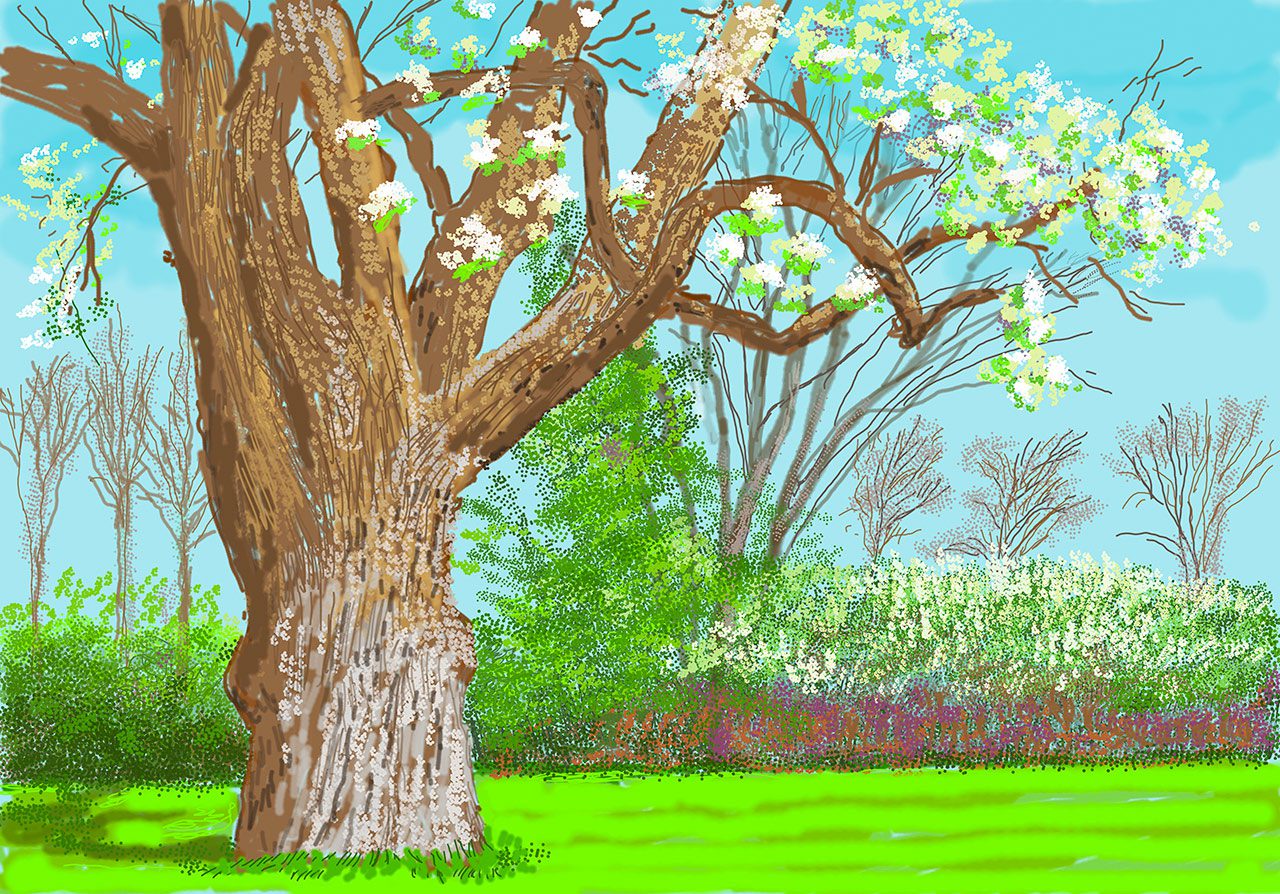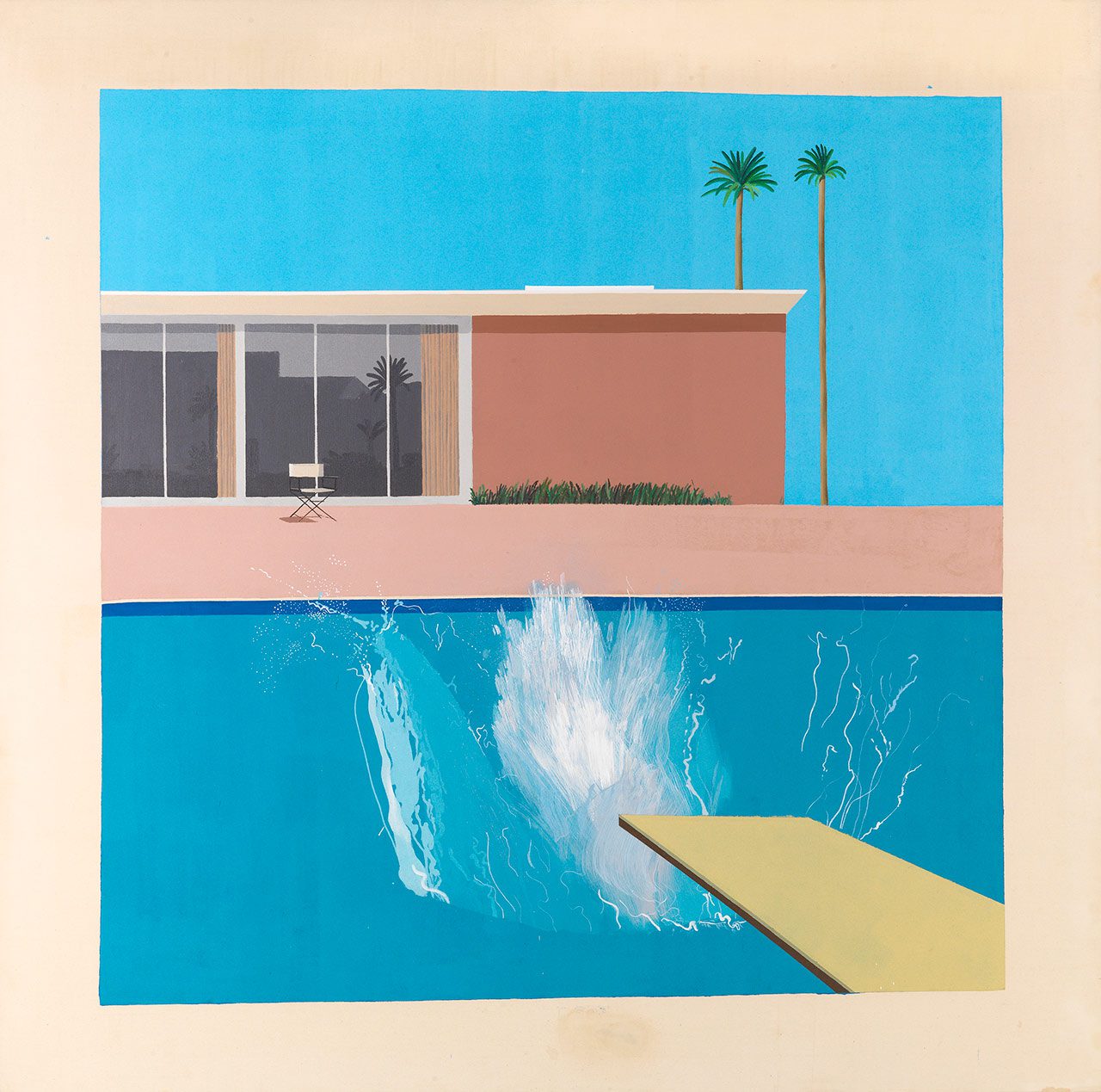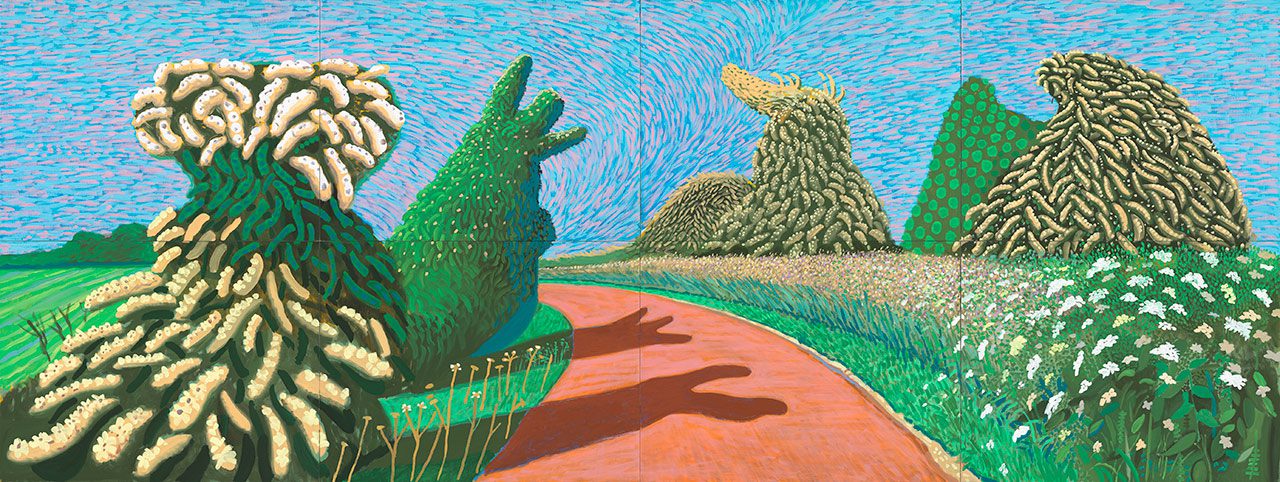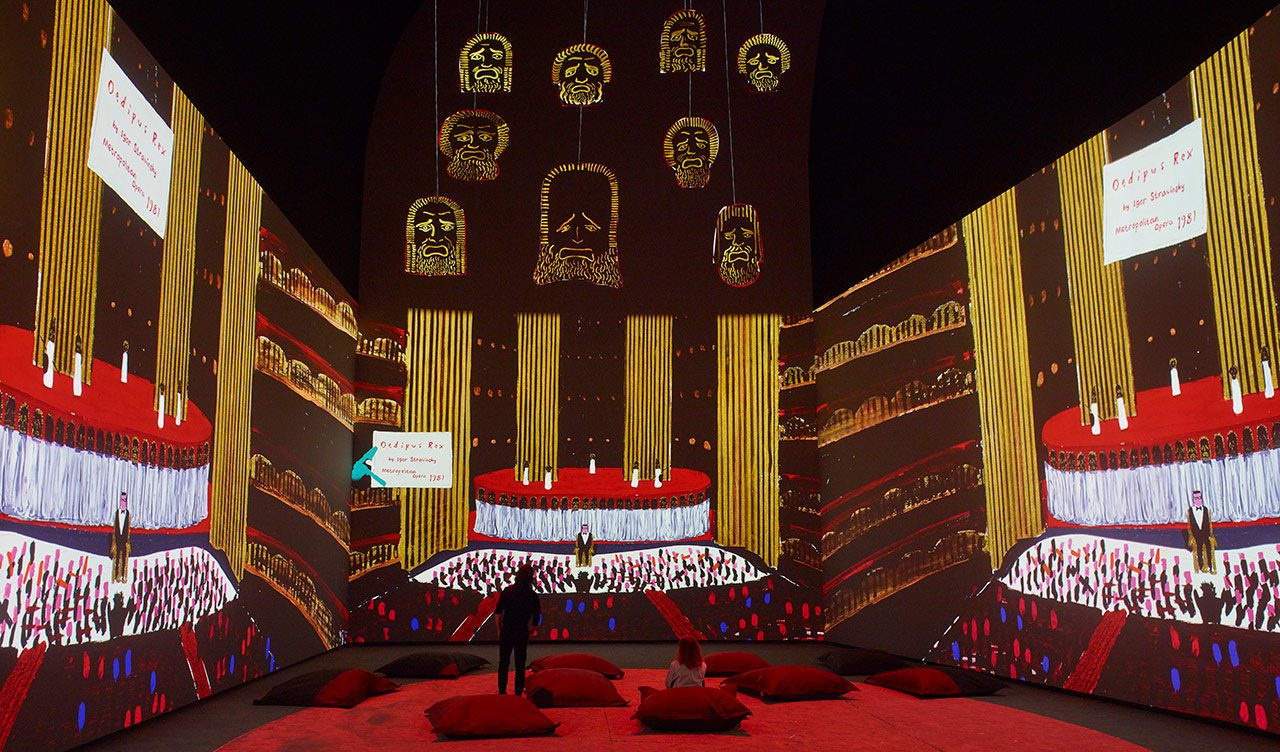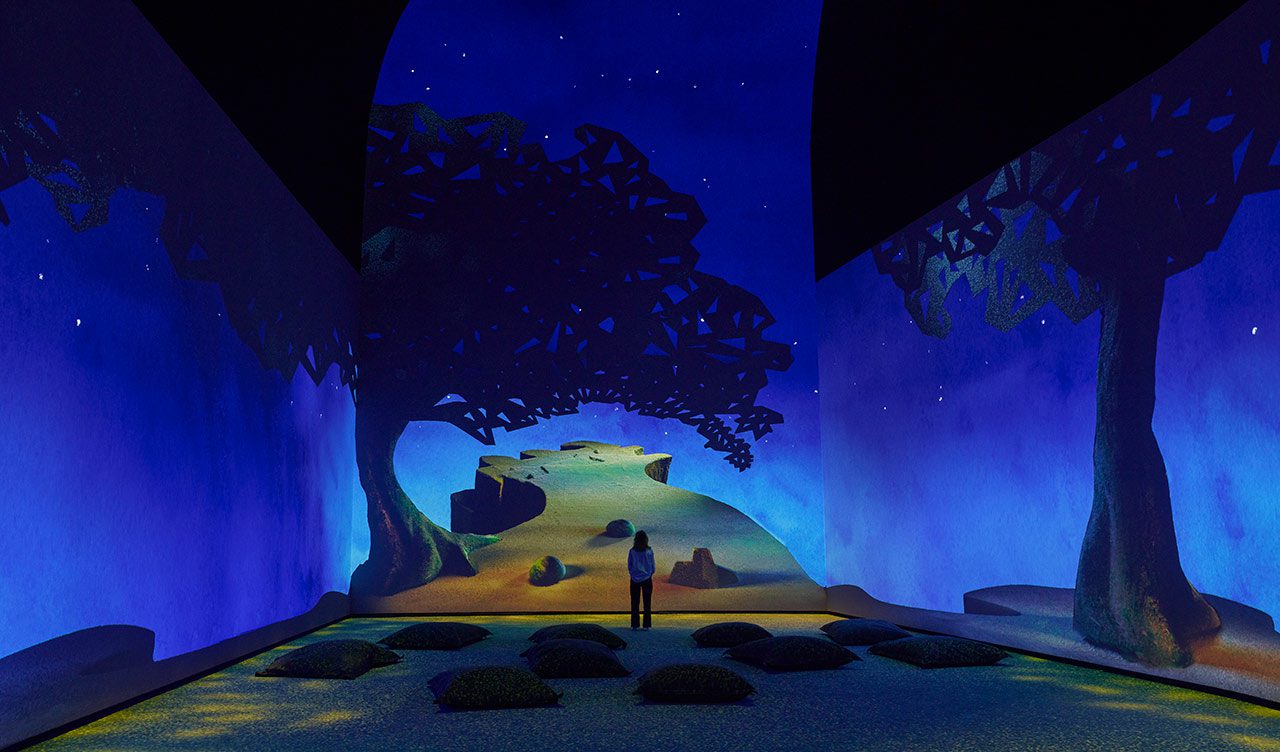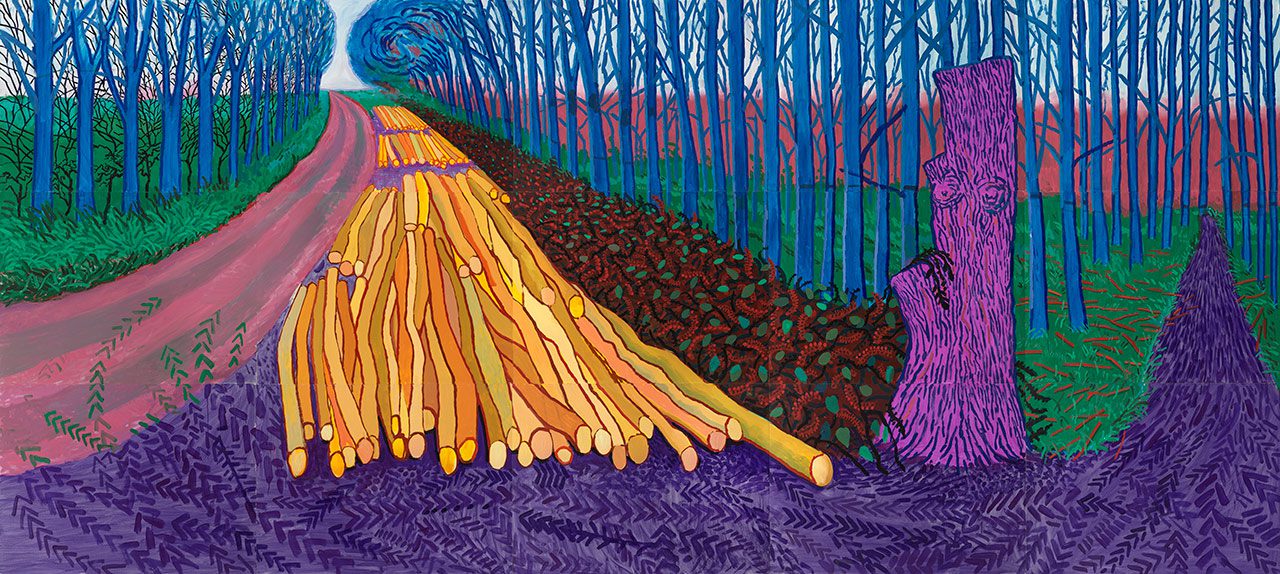TRIBUTE:David Hockney-David Hockney 25
David Hockney has been at the forefront of the international art world for more than six decades. He emerged as one of the exceptional talents in the new generation of British artists in the early 1960s. Throughout his extraordinarily prolific career, he remains endlessly inventive and committed to celebrating the world around him. In the darkest days of the Covid lockdown, he delighted the world with his iPad paintings of Spring and renewal as an antidote to the uncertainty brought about by the pandemic.
By Efi Michalarou
Photo: Fondation Louis Vuitton Archive
For the exhibition, “David Hockney 25”, the artist has chosen to focus on work from the last 25 years. First, we follow David Hockney from Bradford to London, New York, and Los Angeles, before the exhibition turns to the landscapes of Yorkshire and Normandy, and his return to London in 2023. Born in 1937, Hockney grew up in the postwar years in the North of England, in the working- class town of Bradford. He ventured to London at the end of the 1950s, when he enrolled at the Royal College of Art and became one of the leading figures of the Swinging Sixties. In 1964, he moved to Los Angeles. It was there that his swimming pool and double portrait series (1967-1972) were born, and he then went on to paint large landscapes, such as “A Bigger Grand Canyon” (1998). Yorkshire is at the heart of this exhibition, its rolling roads, its fields and woodlands contrast with the vastness of the landscapes of the United States. At the same time, Hockney continued to paint portraits of his friends and self-portraits, in acrylic or on an iPad. In the latter, the artist reveals himself to the point of caricature, while the portraits always remain kind. For the most monumental of the galleries, David Hockney the opera lover has conceived a polyphonic creation, a synthesis of sets and costumes designed for the stage since the 1970s in conjunction with 59 Studio. The exhibition concludes with two “more spiritual” new paintings evoking Edvard Munch and William Blake, as well as a self-portrait recently painted in London. Hockney greets us when we arrive at this exhibition, and accompanies us throughout the visit, to its very end. Here, the artist reveals his concept of art as sharing and his appetite for life and the world. The exhibition is divided in the following themes: From Bradford to London (1955-1963): The exhibition opens with David Hockney’s portrait of his father (1955), which drew immediate attention and was shown at the Leeds Art Gallery in 1957. At the end of the 1950s, Hockney began studying at the Royal College of Art in London, where he frequented museums and took part in the flourishing art scene. From the start, he favored a figurative style that he has never abandoned, no matter what the prevailing trend of the time. His work from this period is reminiscent of graffiti and Jean Dubuffet’s paintings. In asserting his homosexuality, influenced by readings of the poetry of Walt Whitman and of Constantine Cavafy, the artist was sailing very close to what was still illegal in England at the time. His work was nourished by his travels, to Italy and France, and then to Berlin, New York, and Los Angeles, making the 1960s a period of intense creativity. Londres – Paris – Los Angeles (1964-1998): David Hockney moved to Los Angeles in 1964, then in 1973 to Paris, where he diligently visited museums and showed at the Musée d’Art Moderne de la Ville de Paris / ARC, the Musée des Arts Décoratifs, and the Galerie Claude Bernard. He met many artists and worked with Atelier Crommelynck, before returning to Los Angeles in 1978. This exhibition brings together paintings celebrating hedonistic, sunny, and liberated California, through works that have become legendary: “A Bigger Splash”, “Portrait of an Artist (Pool with Two Figures)”, and “The Room, Tarzana”. The paintings are striking in the simplicity of their composition, the clarity of the image, and the transparency of the light, giving the scenes a sense of softness in their explicit eroticism. The architectural and natural environment is reduced to the essential: flat areas of vivid colors, for which photographs were among the sources of inspirations. Two iconic double portraits: “Christopher Isherwood and Don Bachardy” and “Mr and Mrs Clark and Percy” – revisit the tradition of the conversation piece. These were followed, in the 1980s and 1990s, by new American landscapes, as Hockney visited Arizona and the Grand Canyon. These sites were more than subjects: they inspired Hockney to see things in new ways, influencing works made in Los Angeles such as “Nichols Canyon”, seen from above with a raised horizon, marking a turning point. To tackle the Grand Canyon’s immensity, Hockney assembled the 60 canvases, painted in oil, of “A Bigger Grand Canyon” in his LA studio in an expansive, simultaneous juxtaposition of various points of view. Return to Yorkshire (1997-2013): In the late 1990s, Hockney began spending more time in Yorkshire, in the North of England, where he was born. Following the death of his beloved mother in 1999, he decided to settle there, while still returning to Los Angeles regularly. The urge to paint the region, far from the spectacular vistas of California and the American Southwest, encouraged him to explore a scale at once intimate and imposing, for which he defined an effective visual language. He multiplied viewpoints and techniques. New bodies of work emerged, absorbing him for almost a decade.After having lived mainly in California since the mid 1960s, Hockney faced another challenge in Yorkshire: how to capture the changing seasons and their constant variations. Inspired by the great English landscape painters, John Constable and J. M. W. Turner, Hockney returned to traditional techniques – watercolor, charcoal, oil, etc. – working en plein air, while also using photography and computers to complete his largest work, :Bigger Trees near Warter or/ou Peinture sur le Motif pour le Nouvel Age Post-Photographique”.
Portraits and Flowers: David Hockney has always painted his family and friends – the portrait of his father (1955) opens the exhibition. Works created in California, Yorkshire, Normandy, and London over the last 25 years are brought together here. The artist has employed an array of techniques and supports: computer, digital tablet, simple paper, and the camera lucida, the optical device he used for his portraits of museum security guards after Ingres. Hockney continues, though, to use brush, acrylic and oil. His subjects stand out against a blue background, recalling his early California paintings, or, more recently, against a white background, sometimes outlined with a border. Computer technology has allowed him to experiment with new ways of working with the subject. He began using a computer in 2008, and then the iPhone and iPad when they were launched. One result is a series of self-portraits that are not afraid of self-derision. Technology also allows him to create multiple versions of himself, complete still lifes on the iPad, even framed as if they were old paintings. These “flower portraits,” which can be seen in the second gallery, seem to engage with the portraits of his friends. Four years in Normandy (2019-2023): In 2020, confined to the Normandy village where he had bought a house, Hockney began sending iPad drawings to his friends to lift their spirits. Among these images, he drew daffodils along with the first mention of the phrase, “Do remember, they can’t cancel the spring”. In a continuation of this exercise in looking at his immediate surroundings, Hockney set himself the task of realizing 220 Norman views in 2020. The series, “220 for 2020”, treats just a few hectares, where the artist found an infinite number of subjects, near and far. Here, once again, Hockney celebrates the subtleties of change, seasonal and daily, painting plants in all their states, using the iPad to revisit the same motif, thus renewing his work in a continual and rapid way. The selection of works shown here does not represent the idea of a unified cycle, but takes singular moments from across the seasons. Thanks to the screen’s luminosity, Hockney was able to paint the night and capture its magic in the “Moon Room.” The tablet also allowed him to play with the scale of his works, adapting the size of prints the museum’s space. While these “iPad paintings” are exhibited framed, underlining the importance of the artist’s gesture rather than means, Hockney has not given up traditional painting, and continues working with acrylics. While crossing the English Channel one day in October 2018, on the way to Bayeux to see Queen Matilda’s tapestry again, David Hockney decided to stay in Normandy and paint the seasons. In the garden of the property, La Grande Cour, Hockney used acrylics to capture an apple tree, a pear tree, and a quince tree at the end of summer. Each one is individualized, with its own soil and its own sky. All share a very particular touch, in relief and curved, a distant evocation of that of Van Gogh, occasionally smooth or more iridescent. The series in this room depicts the artist’s immediate environment. Some of the works were painted in situ in Normandy, while others were created from memory in his Los Angeles and London studios. They are testament to the continual reinvigoration of his style, with painting remaining his favorite medium. La Grande Cour (2019): This panorama of 24 ink drawings, reveals views of a property in the Pays d’Auge, where he regularly stayed between 2019 and 2023. In Normandy, the traditional layout of the buildings like this is called a “clos”. The immediate surroundings play out like a film – 24 images per second – inviting the viewer to travel with their gaze. The work echoes the Bayeux Tapestry, which Hockney had seen not long before completing this work. Freed from the constraints of perspective, he was impressed by the “absence of vanishing points and shadows.” Almost seventy meters long, the tapestry tells the story of England’s conquest by William the Conqueror, Duke of Normandy, in 1066. Scenes depicting multiple temporalities are represented on the same surface. Rather than a heroic story, in Hockney’s work we find fruit trees, a pond with irises, a stream, and glimpses of the surrounds, including cars parked in the courtyard. At the center of all these elements are his house and outbuildings, seen from the four cardinal points. Less Is Known Than People Think: Today, David Hockney lives in London, where he has recently completed paintings inspired by Edvard Munch and William Blake. “After Munch: Less Is Known than People Think” echoes a small drawing by the Norwegian master that he saw in a catalogue for a recent exhibition at the Museum Barberini in Potsdam, while the title comes from a 1998 New York Times article on the unknowable in science, which Hockney pinned up in his studio.The second painting, “After Blake: Less is Known than People Thin”k, refers to that artist’s illustrations for Dante’s Divine Comedy. As always with Hockney, the two works deal with space, and have, according to him, a “more spiritual” dimension. In his most recent self-portrait, “Play within a Play within a Play and Me with a Cigarette” Hockney has depicted himself dressed in a tweed suit, sitting in his garden. On the painter’s lap we see the collage of the work in progress, announcing the arrival of spring.
Photo: David Hockney, Winter Timber, 2009, Oil on 15 canvases (36 x 48″ each), 274.32 x 609.6 cm (108 x 240 Inches), © David Hockney, Photo Credit: Jonathan Wilkinson
Info: Curators: Suzanne Pagé, Sir Norman Rosenthal, François Michaud, Assistant Curator: Magdalena Gemra, Collaborators: Jean-Pierre Gonçalves de Lima and Jonathan Wilkinson, Fondation Louis Vuitton, 8 Av. du Mahatma Gandhi, Paris, France, Duration: 9/4-31/8/2025, Days & Hours: Daily 10:00-18:00, www.fondationlouisvuitton.fr/

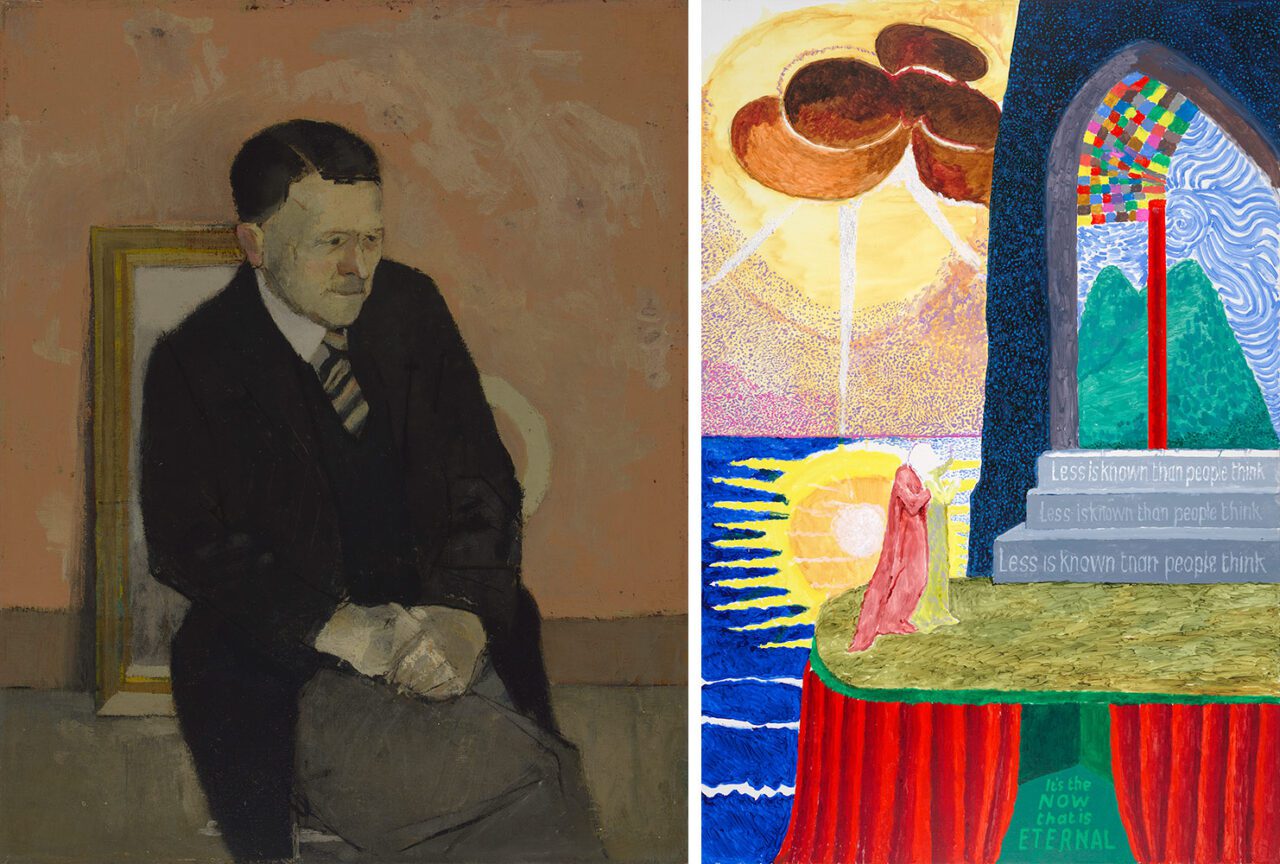
Right: David Hockney, After Blake: Less is Known that People Think, 2024, Acrylic on canvas, 72 x 48″, © David Hockney, Photo Credit: Jonathan Wilkinson
